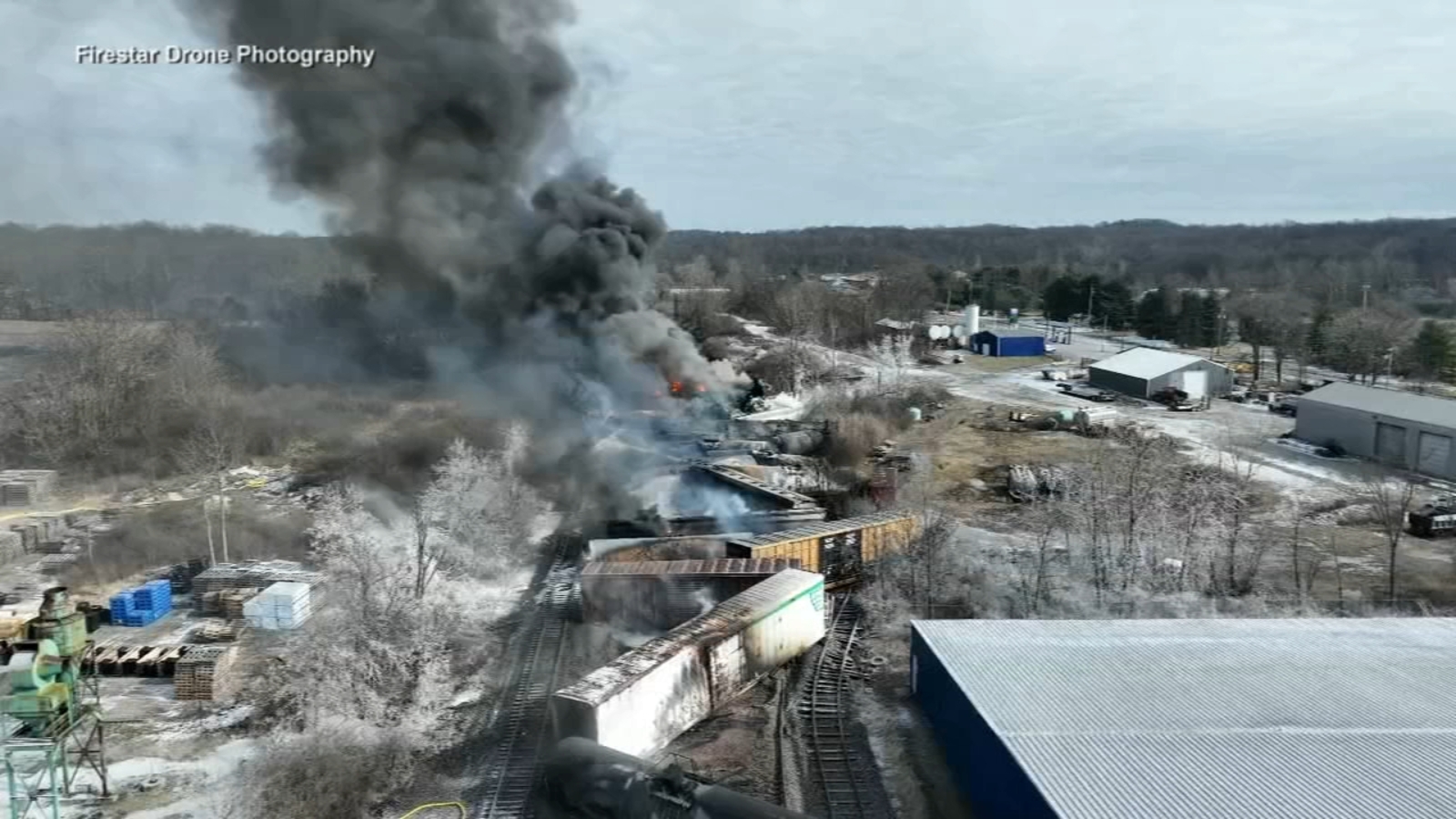Ohio Train Derailment: Investigation Into Long-Term Toxic Chemical Presence In Buildings

Table of Contents
Assessing the Extent of Chemical Contamination in Buildings
The derailment released a cocktail of toxic chemicals, most notably vinyl chloride, but also butyl acrylate and ethylhexyl acrylate, among others. These substances pose significant long-term health risks if they persist in buildings.
Vinyl Chloride and Other Toxic Substances
Vinyl chloride, a known carcinogen, is particularly concerning due to its volatility and potential to seep into building materials. Other released chemicals also present dangers.
- Persistence in Building Materials: Porous materials like drywall, wood, fabrics, and insulation readily absorb these chemicals, making complete decontamination challenging. The chemicals can off-gas slowly over time, leading to prolonged exposure. Detecting low-level contamination requires sophisticated testing methods.
- Testing Methods: Several methods are employed to assess contamination levels. Air sampling measures airborne concentrations. Surface swabbing identifies surface residues. Material analysis involves testing building components for chemical penetration. These methods are crucial in determining the extent of the contamination and informing remediation strategies.
Investigative Approaches and Challenges
Determining the extent of contamination presents numerous complexities.
- Access and Variability: Gaining access to all affected buildings for testing can be difficult. Contamination levels vary significantly from building to building and even within a single structure, complicating the assessment process.
- Cost and Time: Thorough testing and remediation are costly and time-consuming, demanding significant resources. The scale of the disaster underscores the challenges in undertaking this task comprehensively.
- Agency Involvement: The Environmental Protection Agency (EPA), Ohio EPA, local health departments, and other agencies are involved in the investigation, coordinating efforts to ensure a comprehensive assessment. Their collaboration is crucial for efficient and effective action.
Long-Term Health Risks Associated with Chemical Exposure
Exposure to the chemicals released in the derailment poses serious long-term health risks to East Palestine residents.
Potential Health Impacts of Vinyl Chloride and Other Chemicals
Vinyl chloride is linked to various cancers, including liver, lung, and brain cancers. Long-term exposure to butyl acrylate and ethylhexyl acrylate can cause respiratory irritation, skin problems, and other health issues.
- Health Problems: Potential health consequences range from respiratory problems and liver damage to increased cancer risk. These effects may not manifest immediately, making long-term monitoring crucial.
- Research and Studies: Numerous studies document the health effects of these chemicals. Access to these research findings is vital for understanding the potential long-term impact on the community. The need for ongoing research specific to the East Palestine situation cannot be overstated.
- Ongoing Health Monitoring: Continuous health monitoring of residents is essential to detect any emerging health problems and provide necessary medical care. This requires a robust and well-funded health surveillance program.
Addressing Community Health Concerns
The emotional toll of the disaster extends beyond physical health.
- Mental Health Support: The stress, anxiety, and fear experienced by the community demand readily available mental health services.
- Resources and Assistance: Access to resources such as health screenings, mental health counseling, legal assistance, and financial aid is crucial for community recovery. These services must be readily accessible and culturally sensitive.
The Cleanup Process and Future Mitigation Strategies
Remediating contaminated buildings and preventing future incidents are paramount.
Decontamination and Remediation Efforts
Cleaning and remediating affected buildings involves several steps.
- Contaminated Material Removal: This includes removing and properly disposing of contaminated building materials, such as drywall, insulation, and flooring.
- Surface Cleaning and Air Purification: Thorough cleaning of surfaces and air purification systems are vital in reducing chemical levels. Specialized cleaning techniques may be necessary.
- Waste Disposal: Safe and environmentally sound disposal of contaminated materials is critical to prevent further environmental damage.
Preventing Future Incidents
Preventing similar tragedies necessitates comprehensive changes.
- Transportation Safety: Stricter regulations and enhanced safety protocols for the transportation of hazardous materials are needed.
- Emergency Response: Improved emergency response plans and training are vital for better handling of future incidents.
- Infrastructure Investment: Investments in safer and more resilient transportation infrastructure are crucial. This includes improved track maintenance and derailment prevention technologies.
- Regulatory Enforcement: Stricter enforcement of existing regulations is necessary to ensure compliance and deter negligence.
Conclusion
The Ohio train derailment's impact extends far beyond the initial emergency response; the long-term presence of toxic chemicals in buildings poses a significant and ongoing threat to public health in East Palestine. Comprehensive investigations into the extent of contamination, coupled with effective remediation strategies and enhanced safety protocols, are crucial to mitigate the risks. Ongoing monitoring of both environmental conditions and residents' health is essential. Understanding the implications of the Ohio train derailment and the potential for long-term toxic chemical presence in buildings is paramount for protecting the community and preventing future tragedies. We must demand transparency and accountability to ensure the safety and well-being of all affected residents. Stay informed about the ongoing investigations and advocate for comprehensive cleanup and long-term health monitoring in East Palestine. Demand action to prevent future occurrences of this devastating toxic chemical contamination.

Featured Posts
-
 Woman 23 Believes She Is Madeleine Mc Cann New Dna Test Results
May 09, 2025
Woman 23 Believes She Is Madeleine Mc Cann New Dna Test Results
May 09, 2025 -
 The Kilmar Abrego Garcia Case Examining The Intersection Of Immigration And Politics In The Us
May 09, 2025
The Kilmar Abrego Garcia Case Examining The Intersection Of Immigration And Politics In The Us
May 09, 2025 -
 I Epidrasi Tis Klimatikis Allagis Sta Xionoskepi Imalaia
May 09, 2025
I Epidrasi Tis Klimatikis Allagis Sta Xionoskepi Imalaia
May 09, 2025 -
 Stock Market Live Sensex And Nifty Gains Key Movers Today
May 09, 2025
Stock Market Live Sensex And Nifty Gains Key Movers Today
May 09, 2025 -
 Dakota Johnson Ma Dvojnicku Na Slovensku Neuveritelna Podobnost
May 09, 2025
Dakota Johnson Ma Dvojnicku Na Slovensku Neuveritelna Podobnost
May 09, 2025
Latest Posts
-
 Star Stylist Elizabeth Stewart And Lilysilks Spring Collaboration A Luxurious Collection
May 09, 2025
Star Stylist Elizabeth Stewart And Lilysilks Spring Collaboration A Luxurious Collection
May 09, 2025 -
 Bbc Strictly Come Dancing Wynne Evanss Statement On Potential Return
May 09, 2025
Bbc Strictly Come Dancing Wynne Evanss Statement On Potential Return
May 09, 2025 -
 Maldives Vacation Elizabeth Hurleys Bikini Fashion
May 09, 2025
Maldives Vacation Elizabeth Hurleys Bikini Fashion
May 09, 2025 -
 Wynne Evans Addresses Strictly Come Dancing Return Calls
May 09, 2025
Wynne Evans Addresses Strictly Come Dancing Return Calls
May 09, 2025 -
 Elizabeth Hurley Rocks Bikinis In The Maldives A Look At Her Vacation Style
May 09, 2025
Elizabeth Hurley Rocks Bikinis In The Maldives A Look At Her Vacation Style
May 09, 2025
